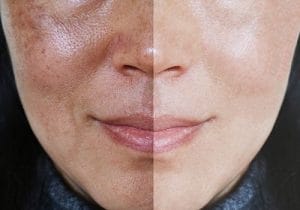
Richard Phibbs for Harper’s Bazaar
Often coined the ‘sun mustache’ or ‘pregnancy mask’, melasma is a common skin pigmentation disorder that can appear in various ways.
While melasma is harmless, these dark patches can be frustrating to live with – something cosmetic dermatologist Dr Sam Bunting understands from her Marylebone clinic. She explains more patients are coming to see her for hyperpigmentation than ever before. “Women (and men) are starting to grasp that an uneven skin tone can be terribly ageing. Lines and wrinkles matter less when the skin reflects the light and is a clean, bright canvas – which doesn’t happen when there are light-absorbing splodges everywhere.” Ageing aside, it can also mean an entire make-up rethink in terms of products and application technique.
Right now the commonest pigmentation disorder Dr Bunting treats is melasma, which can appear on the cheekbones, the forehead and upper lip in people of all ethnicities. The cause? “Sun is an important trigger,” she says, and aesthetic doctor Barbara Kubicka concurs. She points out that melasma can be more common in darker skin tones, because of sun exposure as much as genetic predisposition. “As darker skin contains more pigment (or more active pigment), issues including melasma can be more common, but those with darker skin types very rarely use sun protection, believing that as their skin doesn’t burn they don’t need to use it”.
Secondly, the condition “is often offset by a hormonal change like starting the oral contraceptive pill, pregnancy or even HRT,” Dr Bunting adds – further explaining melasma’s nicknames. In this case, “if a new medication is the provoking influence, stopping it can resolve melasma, but alas not always.”
In fact, melasma rarely resolves itself and is notoriously tricky to treat.
Topical treatments
Prevention is better than cure, and the importance of high quality sunscreen should never be underestimated. “Almost everyone under-applies sunscreen,” Dr Bunting notes, but she stresses that “it is the most important anti-ageing ingredient we have, provided it’s used correctly”. Hence the need for an elegant formula that you actually want to use.
Dr Bunting says, “I like sunscreens which utilise physical blocker zinc oxide in treating melasma, so UV is deflected away from the skin like a mirror. I also make sure patients are equipped with water-resistant SPF for hot weather/outdoor activity. The final consideration is using sunscreen and make-up that contains iron oxide, as we know it blocks visible light which is also a melasma driver.”
Next-up, consider medical grade skincare.
One option is a cream containing skin-lightening hydroquinone, which is only available on prescription in the UK. While considered highly effective, on the flip-side this ingredient can be an irritant. Also, Dr Kubicka reinforces that it shouldn’t be used for extended periods of time. “Hydroquinone used for a long time especially on darker skin types can lead to greyish appearance of the skin called ochronosis,” she warns.
There are other active ingredients that can claim success. “Skin product with azelaic acid, kojic acid, arbutin can be used on all skin types,” Dr Kubicka explains, “but they might not be effective for the active stage of melasma”.
This is why Dr Bunting treats melasma with a tailored medical-grade skincare system combining multiple ‘actives’ to subdue the over-active pigment cells and eliminate the excess pigment already in the skin. “Given that problems like this are often an inherent part of you, and tend to require a long-term strategy, this approach works brilliantly,” she says. When seen regularly, she can advise patients on more aggressive or gentle applications to suit the seasons and their schedules.
While countless products on the shelves claim to reduce pigmentation disorders, know that cosmetic skincare can only do so much. Products we’d recommend include Murad’s Rapid Age Spot and Pigment Lightening Serum which contains a hydroquinone alternative; Medik8’s White Balance Original Serum with kojic acid; Paula’s Choice Resist Skin Transforming Multi-Correction Treatment, containing azelaic acid; and Dr. Dennis Gross Skincare’s Ferulic + Retinol Wrinkle Recovery Overnight Serum formulated with liquorice root, thought to help brighten the skin.
Peels and lasers
Many skincare professionals swear by chemical peels and laser skin lightening to treat melasma. However, Dr Bunting warns, “very commonly melasma can be made worse by ‘physical’ treatments likes microdermabrasion, laser and chemical peels, especially in inexperienced hands” – so approach with caution.
Esteemed London ‘super facialist’ Teresa Teresa says the Cosmelan Depigmentation Peel “is hands down the best way to treat melasma in-clinic and then with at home maintenance”.
This chemical treatment uses azelaic acid and kolic acid in favour of hydroquinone. With a Cosmelan treatment Tarmey says to expect “a slight burning and tightening of the skin and if your skin is sensitive, you might also notice some itchiness, but a hydrating cream will make things more comfortable.” There is some ‘downtime’, in that you will notice significant skin shedding as the peel speeds up the cell turnover process.

Getty Images, Carla Nichiata
Dr Kubicka also performs this treatment, and says that this type of combination peel is effective yet safe for all skin types. Laser treatments can be a different story.
“IPL and most lasers sometimes used for resistant forms of melasma are contraindicated for those with darker skin types because of risk of burns or hyperpigmentation being very high,” Dr Kubicka explains. Tarmey, too, wouldn’t personally recommend lasering melasma, so think twice before going down this route.
As with many skin disorders, melasma is a complicated subject with endless variables. Therefore, the best advice (after slathering on your SPF) is to see out a skincare professional to get theirs. Or, of course, embrace your face the way it is.
From: Harper’s BAZAAR UK



